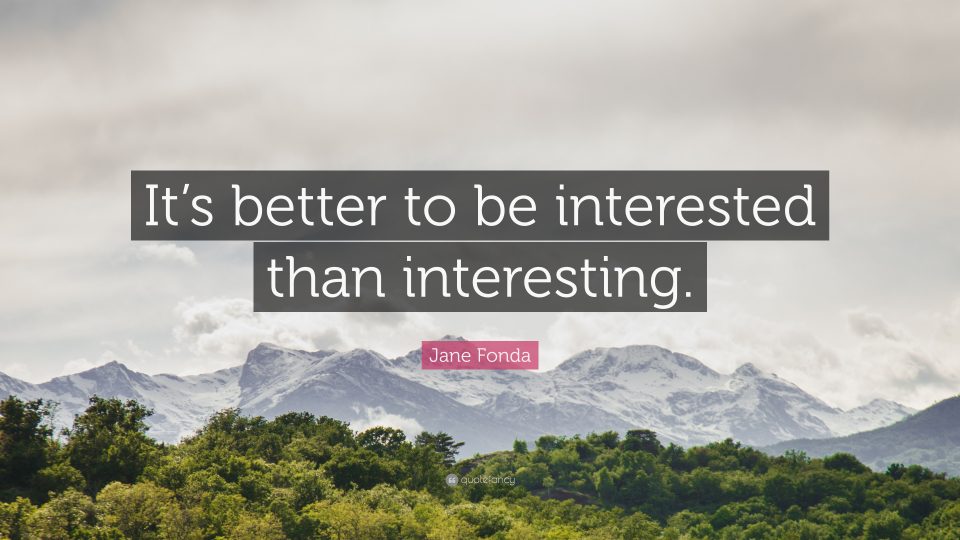This year when we tried to get my 9-year-old son to eat a green bean, he threw up. Right there at the dinner table. To say he’s a picky eater is not just an understatement, but an insult to me as a parent. This dude likes bread, dairy, apples, bacon and is pretty much terrified of everything else.
So what do the specialists do to treat these issues and make him less afraid of foods? They want him to play Food Scientist. They have him smell, touch, and look at the food and make observations and predictions. If they can get him to get curious about a new food, they might get him to learn about it and be less afraid of it, taste it and maybe even enjoy it!
Curiosity kills fear. This has come up again and again in my improv and applied improv work. When I’m teaching Persuasive Communication, the very first step in the Four-Part Persuasive Process is Get Curious. When I’m teaching Medical Communication classes and focusing on building rapport and quickly creating a therapeutic alliance with patients, we focus on being curious. Like Jane Fonda said (and my great friends Aden Nepom and Gary Hirsch at On Your Feet told me), “it’s better to be interested than interesting.” In my Improv Skills for Work and Life program, when I teach Yes And, I invite participants to get curious about what could be (which is another way to Yes And), instead of focusing on what won’t work (like saying Yes But.)

When I co-taught an Improv for Therapists class with known polymath and my dear friend Lacy Alana, Founder of Yes And Brain, she and I talked a lot about curiosity. Therapists of course are curious about their patients and often ask questions to draw them out. And they are often trying to get patients to be curious about their own lives and thoughts. This can help them dismantle stuck thoughts, breakthrough self-imposed limits or chip away at hopelessness with an increased sense of possibility. Lacy pointed out to me how curiosity is such a fundamental part of improv and imbued in so much of our work but there are few exercises that specifically teach that skill.
So she taught me a game she made up and it’s my new favorite! It’s simple, quick, and a low-risk conversational activity. I invite you to do it at your next mealtime or when you’re bored in the car. It’s called “I Know/I Wonder.” To begin, pick a simple topic everyone is familiar with, like turtles or pizza. In the first round of the game, participants take turns saying “I know…” statements about the topic for a minute. For example:
Player 1: I know turtles are reptiles.
Player 2: I know turtles have shells.
Player 1: I know some people eat turtles in soup.
Player 2: I know being slow is associated with turtles. And so on until the minute is up. In Round 2, participants take turns saying “I wonder…” statements about the topic for a minute. For example:

Player 1: I wonder what foods turtles like.
Player 2: I wonder where in the world the most turtles live.
Player 1: I wonder what it’s like to be inside your own shell.
Player 2: I wonder how old the oldest turtle in the world is. After that minute is up, have a discussion about what was different between Round 1 and Round 2. In Round 1 when you are saying what you know, it often feels competitive, people stick to facts, and it can be stressful to come up with things you know that are impressive. In Round 2, the ideas often flow quickly, as others’ curiosity spurs on your own. It gets creative and joyful as smiles spread to faces when silly or outrageous wonderings are shared. It’s such a quick and clear contrast. And you can imagine using this tool when dealing with a problem at work like how will we meet this deadline or at home like what will I make for dinner. Try using “I wonder…” as a prompt when you find your thoughts have come to a dead-end or are feeling stuck.
In today’s polarized political environment, persuasive conversations can quickly turn combative. Often the best you can do to shift someone’s thinking is trying to ask them questions to help them walk through their own beliefs. Curiosity may lead them (or you) down a path of changing their mind. For example, when someone says they don’t want to get vaccinated because it’s not safe. You might ask them what would make it feel safe for them. Or what medical interventions they already use and why. With COVID, what is the best and worst-case scenario for them?
This is similar to the practice of Motivational Interviewing, a tool care providers use to help people with behavior change. The idea is that instead of telling people what they should do to be more healthy, you might ask them what their health or lifestyle goals are, what they are currently doing to achieve those goals, and helping them figure out how they could take a small step towards their stated goals.
Of course, curiosity is important in improv on stage. When we are curious to see where the scene will go, we are more open to exploring other people’s ideas. It suspends judgment and shifts us into a more playful state. It gets us to listen better and to learn more. It propels us into the unknown future the scene is laying out for us. It puts us in a mindset of discovery over invention. It gets us out of our heads and into connection with others. It can decrease conflict and increase imagination.
I wonder… how you are using curiosity in your approach to yourself and your world?

